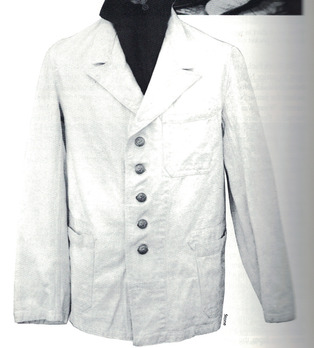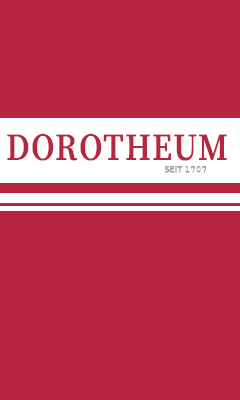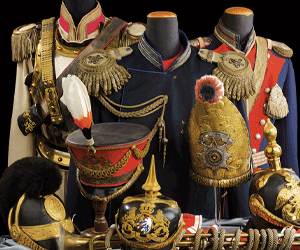Kriegsmarine White Drill Jacket
SKU: 21.GOR.02.01.03.010
Estimated market value:

Estimated market value:
Attributes
History
The headgear, uniforms, and insignia worn by members of the Kriegsmarine were based upon the designs utilized by the Kaiserliche Marine (Imperial Navy) and the Reichsmarine (Navy of the Weimar Republic). The official regulations governing the uniforms of the Reichsmarine were issued on April 5, 1921, and they were embraced, with a few alterations, as the Kriegsmarine uniforms in 1935.
From 1933 to 1945, the uniforms worn by personnel in the German Navy were produced and disseminated by the Navy Clothing Depot and private manufacturers. The cloth was of a high quality prior to the Second World War, but during the war, it became increasingly synthetic and of lower quality. Similarly, the cloth used in the uniforms of Officers and Admirals was of a higher quality than the cloth used in the uniforms of lower ranking personnel, such as Non-Commissioned Officers and Enlisted Men. The cloth utilized in garments of the blue uniform is of an overall better quality than the cloth utilized in the field-grey uniform. For the field-grey uniform specifically, the cloth is more grey-coloured in pre-war uniforms, while the cloth is more green/olive-coloured in wartime uniforms.
The main colour of Kriegsmarine uniform pieces is a dark navy blue. However, during the summer months, and initially also in regions with warmer climate, a white summer uniform was used. Eventually, a brown tropical uniform was introduced for units stationed in tropical and subtropical regions. Land-based Kriegsmarine units, most of which were part of the Coastal Artillery, wore Army-like field-grey uniforms in the style of the Kriegsmarine.
The garments may have proof stamps, serial and unit stamps, and manufacturer marks denoting the legitimacy and origin of the item. They also tend to feature sewn name tabs (Namensläppchen) on all clothing items associated with the blue and field-grey uniforms. The blue uniform garments all have a serial number stamp (Stammrollennummernstempel), while the field-grey uniform garments have a unit stamp.
The proof stamp is present on all garments produced by the Navy Clothing Depot, and it includes the size of the item, if needed, with the year of manufacture above the size, and a surmounting script that reads “B.A.K.” or “B.A.W.”. This stamp information is framed, and written in white ink on blue or black garments and in black ink on all other colour garments.
The serial stamp is composed of letters and numbers, and it is present on blue uniform garments from the Depot. The stamp is either printed in red ink or sewn in red thread. The numbers are preceded by a letter that denotes the area in which the wearer served, with an “N” for Navy Station or an “O” for Navy Station Baltic. The stamp ends in a letter associated with the wearer’s career group, with an “S” for deck personnel and a “T” for technical professionals. Below the serial number is the year in which the wearer entered the navy, surmounted by a horizontal line.
The unit stamp is present on field-grey uniforms. It includes the framed, shortened unit name of the wearer in red ink.
The marks of private manufacturers vary widely, ranging from codes to full names, and even abbreviated letters, as well as the year of manufacture. After 1942, Reich numbers (Reichsbetriebsnummern) were also used as manufacturer marks (RB-).
The buttons worn on Kriegsmarine garments are generally gold-coloured, except for the uniforms of Officials which used silver-coloured buttons. The buttons feature the image of a fouled anchor on the obverse. The buttons are composed of brass, or of light metal. The gold-coloured buttons were gilded, while the silver-coloured buttons were silvered. As well, in the case of special uniform garments the buttons may be composed of plastic.
The Drill Jackets, also known as Work Jackets, came in two forms, the White Drill Jacket and the Field-Grey Drill Jacket. They were worn by Junior Non-Commissioned Officers within specific career branches and roles. The jackets were only permitted for wear while serving on a ship or working in a workshop at Kriegsmarine barracks.
Both the white and grey drill jackets were initially worn by engine personnel. In October 1935, personnel within the carpentry, mechanics, and signals careers were permitted to wear the white drill jacket, and again in December 1938, additional personnel within the administrative, medical, and clerical careers were added to the list of personnel allowed to wear the white drill jacket.
The grey drill jacket remained a garment only for Junior Non-Commissioned Officers within the engine career.
These jackets extend 70mm below the end of the wearer’s torso, and they are composed of several main elements, including the cloth, the collar, the pockets, the buttons, the career insignia, and the rank insignia.
The white drill jackets are made of white-coloured moleskin cloth, while the grey drill jackets feature grey-coloured drill cloth.
The collars of these jackets are reinforced with layered basic cloth and feature an internal lining stiffener.
The jackets have three patch pockets without a flap, comprising two side pockets and a single breast pocket.
The entire jacket is closed by five gold-coloured (gilt) anchor buttons which are located parallel to the seam of the front right panel, while the button holes are located along the left front panel.
While these jackets do not usually feature the national emblem, they do have career insignia on the left sleeve. The career insignia were made with light-blue thread, and embroidered on a white cloth backing for the white jacket and grey cloth backing for the grey jacket. See the sections for Career Insignia for Junior Non-Commissioned Officers within the Career Insignia section for more information.

Versions
$350 USD


Comments
Sign in to comment and reply.


Scroll Top